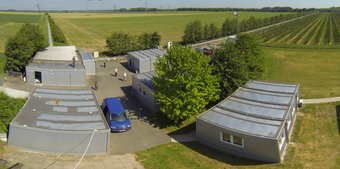On the threshold of a new astronomy – the new generation of gravitational wave detectors: summary and outlook
GEO600 listens in on space until 2015
Scientists from the Albert Einstein Institute Hannover (Max Planck Institute for Gravitational Physics and Leibniz Universität Hannover) and their British colleagues are currently bringing to a close the first phase of their large-scale GEO600 experiment. For over two decades, the physicists there have been developing and testing technologies for gravitational wave detectors. Now, the end of the first leg in the hunt for gravitational waves has been reached: the measurement equipment is up and running in all observatories of the international network, as expected. The German-British GEO600 observatory and the two LIGO detectors in the USA plus the Virgo experiment in Italy are operating very reliably and with high precision. Thus, the preconditions for the next generation of gravitational wave observatories have been established.
“One of the most important experiences from the operation of the first generation of our detectors is that the technology is functioning exactly as we had hoped and expected,” says Prof. Dr. Karsten Danzmann, Director at the Albert Einstein Institute. “Today, our systems take measurements that border on the very limits of what is possible. Nevertheless, there have been no disruptive new physical effects. We were able to show that the technologies, initially developed for a prototype, also work in a more than 100-times bigger experiment dependably and in a controlled manner. Moreover, owing to the continuously improved measuring sensitivity and the thereby resulting data, a number of theoretical astrophysical models were able to be refined. We can therefore determine the geometry of neutron stars with much greater precision today.”
Innovative technologies from Hannover for the international detector network

Within the international network of gravitational wave observatories, GEO600 plays a central role as an experimental technology incubator: here, together with the Laser Zentrum Hannover, is where, for the first time, new, highly stable light sources, were developed and tested, among other things. They alone enable the extremely precise length measurements, which are necessary for the detection of gravitational waves. Now the other observatories are also adopting these technologies. They are an important part of the current reconversion works for the second generation of gravitational wave detectors. Within GEO600 itself, development, experimentation, optimization and - measuring are continuing. While LIGO and Virgo are set to undergo a conversion phase of several years, the German-British observatory will continue to record data, using it to further search for gravitational waves - solo for the time being. A joint science run with Virgo is planned only for summer 2011.
Data analysts are satisfied
The first test phase of the technology development also marks the end of an important period of scientific data recording. After a total of six joint science runs carried out by GEO600, LIGO and, subsequently Virgo, the data analysts are satisfied. Headed by Prof. Bruce Allen, Director at the Albert Einstein Institute Hannover, the team of scientists has set up ATLAS, one of the most powerful high-performance computer clusters in the world, developed algorithms for data analysis, and searched through the enormous amounts of data of the international detector network for gravitational wave signals. They were able to show that both the newly developed analysis methods and the computer technologies are ready for the next big step.
On the road to a new astronomy
Until 2015, the researchers will be upgrading all of the gravitational wave observatories - primarily with technologies that were initially developed for GEO600. These technologies will help Advanced LIGO and Advanced Virgo to attain a 10-times higher sensitivity. The gravitational wave observatories of the second generation will listen in ten-times further in space than before. The observed volume of outer space is thereby enlarged thousand-fold. This means that the number of potential, detectable sources also dramatically increases and with it the chance of directly and regularly measuring gravitational waves. “After the ongoing upgrade of the detectors with new laser sources and improved mirror suspensions, we expect to be able to regularly observe gravitational waves. We estimate that there will be several dozen occurrences per year to measure,” says Karsten Danzmann. “The reconversion and tuning work on the detectors is still a sizeable challenge - however, after the experiences we have made over the past years, we are very confident,” the scientist adds.
As a number of the newly developed measurement technologies for the second generation have already been installed in GEO600, the measurements can continue. Additional improvements on the measuring devices will be carried out incrementally in the coming months during ongoing operation as it were. To this effect, after the joint science run with Virgo in summer 2011, the next step will be the installation of new mirrors in GEO600.
The scientists see the detectors of the second generation as heralding the start of gravitational wave astronomy. The goal is then to observe the universe permanently in the gravitational wave spectrum and to obtain new insights into the still-unknown 96% of our universe, which is not accessible for standard, electromagnetic radiation-based astronomical methods. The well-known “astronomy of seeing” will then go hand in hand with an “astronomy of hearing”.
